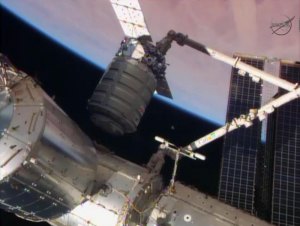
The arrival marked the first successful cargo delivery by Orbital Sciences Corp. of Dulles, Va., for NASA. Astronaut Mike Hopkins of NASA grappled the spacecraft at 6:08 a.m. EST and Koichi Wakata of the Japan Aerospace Exploration Agency attached Cygnus to the space station's Harmony Node at 8:05 a.m.
The Expedition 38 crew members aboard the station will begin unloading the 2,780 pounds (1,261 kilograms) of supplies aboard Cygnus following the hatch opening planned for Jan. 13.
The cargo comprises vital science experiments, crew provisions, spare parts and other hardware. This includes 23 student-designed science experiments. One newly arrived investigation will study the decreased effectiveness of antibiotics during spaceflight. Another will examine how different fuel samples burn in microgravity, which could inform future design for spacecraft materials.
Orbital's Cygnus was launched on the company's Antares rocket Jan. 9 from NASA’s Wallops Flight Facility in Virginia. Cygnus will remain attached to Harmony until February, when it will be detached and sent toward a destructive re-entry in the Earth's atmosphere.
Orbital Sciences is one of two companies that built and tested new cargo spacecraft under NASA's Commercial Orbital Transportation Services (COTS) program. COTS was completed late last year with an Orbital Sciences demonstration mission to the space station. Space Exploration Technologies Corp. (SpaceX), the other company that partnered with NASA under COTS, also is providing commercial resupply services for the agency.
In addition to cargo flights, NASA's commercial space partners are making progress toward a launch of astronauts from U.S. soil within the next three years.
The International Space Station is a convergence of science, technology and human innovation that demonstrates new technologies and makes research breakthroughs not possible on Earth. The space station has been continuously occupied since November 2000. In that time, it has been visited by more than 200 people and a variety of international and commercial spacecraft. The space station remains the springboard to NASA's next great leap in exploration, including future missions to an asteroid and Mars.
Related:
NASA video: Cygnus Arrives at International Space Station
Science, NASA cargo launches to space station
NASA TV to air Orbital Sciences mission to International Space Station
NASA video offers highlights of Dec. 21 spacewalk
NASA video explains spacewalks
Space Station: repair spacewalks possible